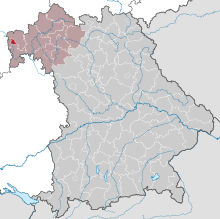Our website is made possible by displaying online advertisements to our visitors.
Please consider supporting us by disabling your ad blocker.
Aschaffenburg
This article needs additional citations for verification. (January 2017) |
Aschaffenburg | |
|---|---|
 Schloss Johannisburg on the river Main | |
| Coordinates: 49°58′N 9°09′E / 49.967°N 9.150°E | |
| Country | Germany |
| State | Bavaria |
| Admin. region | Lower Franconia |
| District | Urban district |
| Subdivisions | 10 districts |
| Government | |
| • Lord mayor (2020–26) | Jürgen Herzing[1] (SPD) |
| Area | |
• Total | 62.45 km2 (24.11 sq mi) |
| Elevation | 138 m (453 ft) |
| Population (2023-12-31)[2] | |
• Total | 72,918 |
| • Density | 1,200/km2 (3,000/sq mi) |
| Time zone | UTC+01:00 (CET) |
| • Summer (DST) | UTC+02:00 (CEST) |
| Postal codes | 63739–63743 |
| Dialling codes | 06021, 06028 (Obernau) |
| Vehicle registration | AB |
| Website | www.aschaffenburg.de |

Aschaffenburg (German pronunciation: [aˈʃafn̩bʊʁk] ⓘ; Hessian: Aschebersch) is a town in northwest Bavaria, Germany. The town of Aschaffenburg, despite being its administrative seat, is not part of the district of Aschaffenburg.
Aschaffenburg belonged to the Archbishopric of Mainz for more than 800 years. The town is located at the westernmost border of Lower Franconia and separated from the central and eastern part of the Regierungsbezirk (administrative region) by the Spessart hills, whereas it opens towards the Rhine-Main plain in the west and the north-west. Therefore, the inhabitants speak neither Bavarian nor East Franconian but rather a local version of Rhine Franconian.
- ^ Liste der Oberbürgermeister in den kreisfreien Städten, Bayerisches Landesamt für Statistik, accessed 19 July 2021.
- ^ Genesis Online-Datenbank des Bayerischen Landesamtes für Statistik Tabelle 12411-003r Fortschreibung des Bevölkerungsstandes: Gemeinden, Stichtag (Einwohnerzahlen auf Grundlage des Zensus 2011).
Previous Page Next Page







